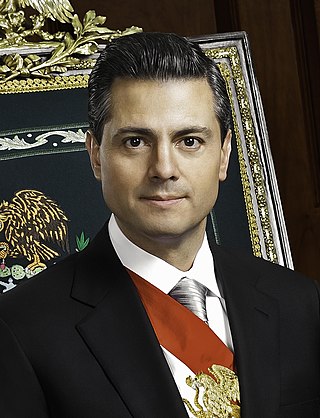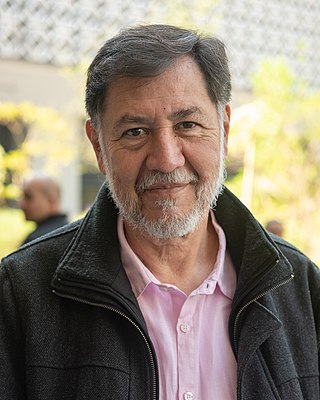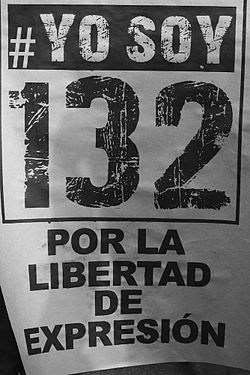
Carlos Salinas de Gortari is a Mexican economist and politician with Spanish citizenship who served as the 60th president of Mexico from 1988 to 1994. Affiliated with the Institutional Revolutionary Party (PRI), earlier in his career he worked in the Secretariat of Programming and Budget, eventually becoming Secretary. He secured the party's nomination for the 1988 general election and was elected amid widespread accusations of electoral fraud.

The Institutional Revolutionary Party is a political party in Mexico that was founded in 1929 and held uninterrupted power in the country for 71 years, from 1929 to 2000, first as the National Revolutionary Party, then as the Party of the Mexican Revolution and finally as the PRI beginning in 1946.

The Ecological Green Party of Mexico is a green political party in Mexico.

Andrés Manuel López Obrador, also known by his initials AMLO, is a Mexican politician who is the 65th and current president of Mexico. He previously served as Head of Government of Mexico City from 2000 to 2005.

Grupo Televisa, S.A.B., simply known as Televisa, is a Mexican telecommunications and broadcasting company. A major Latin American mass media corporation, it often presents itself as the largest producer of Spanish-language content.

Enrique Peña Nieto, commonly referred to by his initials EPN, is a Mexican politician who served as the 64th president of Mexico from 2012 to 2018. A member of the Institutional Revolutionary Party (PRI), he previously served as Governor of the State of Mexico from 2005 to 2011, local deputy from 2003 to 2004, and Secretary of Administration from 2000 to 2002.
This is a list of events that happened in 2006 in Mexico.

The New Alliance Party is a state-level political party in Mexico founded in 2005.
The civil unrest in San Salvador Atenco of 2006 began on Wednesday, May 3, when police prevented a group of 60 flower vendors from selling at the Texcoco local market in the State of México, about 30 km (19 mi) from Mexico City. State police used violence and arrest against resisters. The flower vendors appealed to the residents of San Salvador Atenco, a small neighboring community about 25 km (16 mi) northeast of Mexico City, famous for creating their resistance organization against the development of an airport on their land in 2002.

Luis Videgaray Caso is a Mexican politician who served as the Secretary of Foreign Affairs from 2017 to 2018. Previously he was the Secretary of Finance and Public Credit, also in the cabinet of Enrique Peña Nieto, from 2012 to 2016. Prior to Peña Nieto's victory in the elections, Videgaray was General Coordinator of his campaign for the 2012 Mexican presidential election. On July 11, 2012, Peña Nieto announced Videgaray as the person in charge of promoting the economic reforms and the government agenda's related topics, and on September 4, he named Videgaray as co-head of the team that set policy direction for the new government that took office on December 1, 2012.

General elections were held in Mexico on Sunday, 1 July 2012. Voters went to the polls to elect a new President of the Republic to serve a six-year term, replacing Felipe Calderón, 500 members of the Chamber of Deputies and 128 members of the Mexican Senate.
This is a list of events that happened in 2012 in Mexico. The article also lists the most important political leaders during the year at both federal and state levels.
The security policy of the Enrique Peña Nieto administration that governed Mexico from 1 December 2012 to 30 November 2018 prioritized the reduction of violence rather than attacking Mexico's drug trafficking organizations head-on, marking a departure from the strategy of the previous six years during Felipe Calderón's administration. Peña Nieto has set up a number of conceptual and organizational changes from the past regime policy, and one of the biggest contrasts is the focus on lowering murder rates, kidnappings, and extortions, as opposed to arresting or killing the country's most-wanted drug lords and intercepting their drug shipments. The government of Calderón, however, has justified its position by stating that the current violence in the country is a necessary stage in Mexico's drug war, as weakening criminal groups fight for territorial control against one another and the government. Moreover, part of Peña Nieto's strategy also consists on the creation of a national police made up of 40,000 members, known as a "gendarmerie." He also proposed on centralizing the sub-federal police forces under one command. The president-elect emphasized that he does not support the involvement or presence of armed U.S. agents in Mexico, but considers allowing the United States to instruct Mexico's military training in counterinsurgency tactics. Beyond that, Peña Nieto promised that no other measures will be taken by the U.S. in Mexico. While campaigning, Peña Nieto appointed a former general of the National Police of Colombia as his external advisor for public security, and boldly promised to reduce 50% of the murder rates in Mexico by the end of his six-year term.
This is a list of events that happened in 2013 in Mexico. The article also lists the most important political leaders during the year at both federal and state levels.

General elections were held in Mexico on 1 July 2018. Voters elected a new President of Mexico to serve a six-year term, 128 members of the Senate for a period of six years and 500 members of the Chamber of Deputies for a period of three years. It was one of the largest election days in Mexican history, with most of the nation's states holding state and local elections on the same day, including nine governorships, with over 3,400 positions subject to elections at all levels of government. It was the most violent campaign Mexico has experienced in recent history, with 130 political figures killed since September 2017.

Morena is a major Mexican left-wing political party. It is described as an anti-neoliberal and populist party. It is the ruling party of Mexico since 2018. As of 2023, it is the largest political party in Mexico by number of members.

Mexico City Texcoco Airport was a planned airport in Mexico City that was meant to become Mexico's New International Airport. The project was announced in September 2014 but was canceled in late 2018 after a referendum was held stating that the new airport should be built at a different location due to how close it was to close housing, rising cost and a geographical issue with the site. Felipe Ángeles International Airport opened in March 2022.

José Gerardo Rodolfo Fernández Noroña is a Mexican politician and sociologist from the Labor Party. He is known for his protest acts especially starting with the 2006 presidential election. He was a federal deputy on two occasions between 2009 and 2012, and since 2018 he has been nominated by the PT to run as a candidate for the presidency of the Republic within the Together We Make History coalition for the 2024 federal elections
Peñabots is the nickname for automated social media accounts allegedly used by the Mexican government of Enrique Peña Nieto and the PRI political party to keep unfavorable news from reaching the Mexican public. Peñabot accusations are related to the broader issue of fake news in the 21st century.

Rubén Isaac Albarrán Ortega is a Mexican musician, singer, song writer, music producer, and activist. He is a member and founder of the alternative rock band Café Tacvba. As singer and frontman of Café Tacvba, the artist has characterized himself by his energetic attitude onstage and for presenting himself as different characters and aliases throughout his career.


















